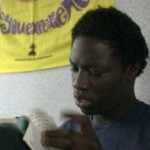Countering Homophobia
Posted Fri Jun 28 14:27:48 PDT 2002 by Helen Rogers (mayoralty@aol.com).
n/a, Pittsfield, MA
Materials Required: Name-calling worksheet and soccer balls
Activity Time: 60-90 minutes
Concepts Taught: Multiculturism, tolerance, diversity
COUNTERING HOMOPHOBIA: A LESSON PLAN
The lesson plan below was adapted from a plan developed by Polly Kellogg.
Objectives:
1) To sensitize students to the feelings of others who are called names because they are “different from other people.
2) To develop an understanding of how and why we react to people who are unlike us.
3) To provide students with the verbal tools to protect themselves and to discourage name-calling.
Time Needed: Two class periods
Lesson Tie-Ins: This lesson can easily be used as a springboard for writing a paper on tolerance and diversity.
Grade Level:
For grades 4-8. The procedures for all grades are the same, though teachers may wish to adjust discussion strategies as appropriate for their grade levels.
Materials Needed:
The name-calling worksheets and the list of feelings that appear on the next page. A number of soccer balls are also required.
Teacher Preparation:
Read “What Do We Say When We Hear ‘Faggot?’” by Leonore Gordon. Review teaching procedures outlined below. Duplicate sufficient copies of name-calling worksheets for each student. Prepare a feeling list by writing a list of adjectives on newsprint or on chalkboard.
Procedure:
Note: It is important teachers feel confident in their ability to provide students with accurate information. Each opportunity must be utilized during class discussion to correct myths and misconceptions about the particular group under discussion.
Call students’ attention to the first type of person listed on the work sheet, i.e. short. Ask the students to suggest different labels or put-downs generally used for people who are short and write them on the board. Then ask the students how they would feel if they were these people and were put-down. Again, write their answers on the board. Finally, tell students that instead of responding to put-downs with more insults, they can respond with something good about what they are, i.e. a short person could say, “So? I’m short. It just means I don’t have to duck as much.” Explain that replying in this way helps diffuse the situation and educate the person putting them down. Have the students fill out the rest of the work sheet themselves. Direct the students’ attention to the feelings list on the board and ask them if they have any other ideas. Once students are finished with their sheets, talk about the students’ results and introduce the idea of stereotypes.
Explain to students that you are now going to talk about people known as gay men, lesbians, or homosexuals. Ask the students if they know what being gay means. After discussion, ask the students if/where they hear people talking about homosexuality and what these people say. Instruct the students to break up into small groups and make a list of words or phrases that come to mind when they hear words like gay, lesbian, or homosexual and what they think of people who are these things. Have them share their results with the class. Now have the students return to their normal seating and discuss the groups’ results. Explain which things on the students’ lists are myth and which are reality. Ask the students to make their own name-calling work sheets and write down how they would feel about being called some of the put-downs used for gays and what comebacks they might use. This should be done interactively with the teacher. Afterwards, have the students color pictures of how they would feel if they were homosexual and put-down. After this is finished, explain to students that being homosexual is just a part of who someone is, and that while they can form their own feelings about homosexuality, they still have to treat homosexuals just like anyone else and that they are deserving of decency and respect. If the myth that gay men/lesbians will automatically “hit” on you if you’re a boy/girl is not brought up and dispelled earlier in class, do so now along with any other important myths you feel have not been addressed.
Move the students to an open area in the room where you have 1-3 soccer balls. Choose a few students to be volunteers and have them “hide” one of their legs by holding it up and standing on one leg. Then ask the students to try dribbling the soccer ball(s). Explain to the students that homosexuals often feel they have to hide an important part of who they are when they’re in public because of fear of discrimination. Explain to the students that homosexuals have just as hard a time functioning in life this way as the soccer player who must hide a leg. Explain how a soccer player shouldn’t have to hide who he or she is, just like a homosexual should not have to. Ask the students how they would feel if they could not admit that they liked boys/girls or playing video games or baseball for fear of being shunned and name-called.
Feelings list: afraid, lonely, mad, happy, embarrassed, bored, loved, I’m the only one like this, cool, ashamed, sad, crazy, scared, alone, weird, part of the group, nobody likes me, on top of the world.






